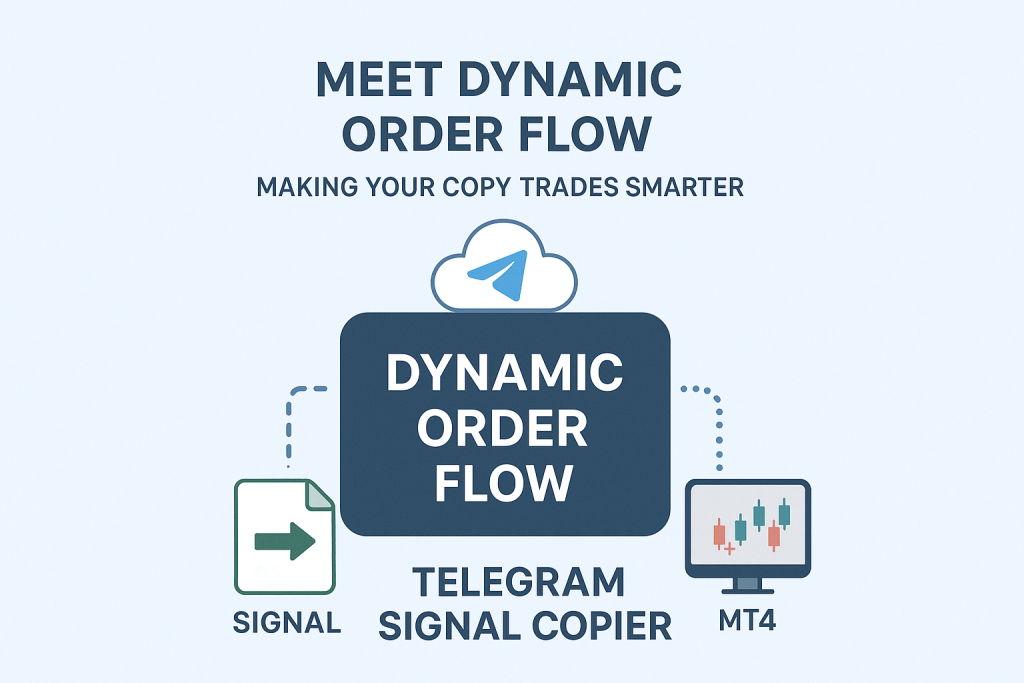$0.00
0 items
 Sign in
Sign inIf you’re using a Telegram signal copier or Telegram copy trader, you already know the biggest frustration: you see a signal come through, but then your broker rejects the order. You think: “What’s going on?” That’s exactly the problem we set out to solve — and the new AI based Dynamic Order Flow feature is […]
If you’re using a Telegram signal copier or Telegram copy trader, you already know the biggest frustration: you see a signal come through, but then your broker rejects the order. You think: “What’s going on?” That’s exactly the problem we set out to solve — and the new AI based Dynamic Order Flow feature is our solution.
In simple terms: Dynamic Order Flow helps improve broker order acceptance when using Telegram to MT4 or MT5. But let’s walk through why this matters, how it works, and what you’ll notice once you start using it.
Many traders want that instant gratification — when a signal hits, they expect the order to fire off at market without delay. But reality is messier.
Signals are built around a fixed entry price, stop loss, and take profit. That works on paper, but real-world markets move quickly. Prices jump, spreads widen, liquidity changes, and broker rules can clash with forced orders. If your copier tries to push an entry that’s already outdated, the broker may reject it.
Rejections usually happen because:
This leads many traders to blame their copier or the signal provider. But often the issue is really about how the orders are sent.

Think of Dynamic Order Flow as a smart translator between your Telegram signals and your broker. Instead of blindly forcing every signal into the market, it:
It doesn’t fight the market. It adapts to it.
For example, if your signal says “Buy EURUSD at 1.1200” but the market is already at 1.1205, a normal copier might try to force the trade and get rejected. With Dynamic Order Flow, the system adapts—delaying slightly, nudging the entry, or handling the submission in a way that keeps it valid.
As a trader, you don’t need to learn new settings or add extra steps. Dynamic Order Flow runs behind the scenes, but you’ll start to notice:
Instead of brute-forcing entries, your Telegram copy trader is now thinking about what the broker will actually accept.
Here’s a simple breakdown of how it works:
This step in the middle is the difference between frustration and smooth execution.
Picture this: A signal says “Buy GBPUSD at 1.3000, SL 1.2980, TP 1.3040.” By the time your copier gets it, the price is 1.3008. A basic system forces the order and gets rejected. Dynamic Order Flow instead checks, sees the mismatch, and adapts — giving you a much higher chance of execution.
That means:
It’s especially valuable during volatile conditions where spreads spike and orders are most likely to fail.
Copy traders rely on their setup to actually place trades when signals come in. Every rejection means a lost opportunity, and too many missed trades erode trust in the whole process. Dynamic Order Flow was designed to bridge the gap between Telegram trade copiers and the reality of broker execution rules.
Instead of brute force, it brings flexibility. Instead of rejections, you see fills. And instead of frustration, you get a smoother, more reliable trading flow.
By integrating Dynamic Order Flow into your Telegram to MT4 setup, you’re making sure your copier works with the market instead of against it. That small difference can mean a lot more successful trades — and a lot less stress when you’re copy trading.